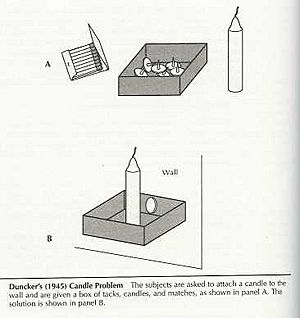Karl Duncker facts for kids
Karl Duncker (born February 2, 1903, in Leipzig, Germany – died February 23, 1940) was a German Gestalt psychologist. He was a smart thinker who studied how people solve problems and why they sometimes get stuck. His ideas are still important in psychology today.
Duncker studied at Friedrich-Wilhelms-University and also spent time in the United States at Clark University in Massachusetts. There, he earned a master's degree. For many years, he learned from and worked with the famous founders of Gestalt psychology in Berlin: Max Wertheimer, Wolfgang Köhler, and Kurt Koffka. These psychologists believed that our minds try to see things as a whole, rather than just small parts.
In 1935, because of the Nazis, Duncker had to leave Germany. He moved to Cambridge, England, where he worked with another famous psychologist, Frederic Charles Bartlett. Later, he moved to the United States and continued to work with Wolfgang Köhler at Swarthmore College. His parents, Hermann and Käte Duncker, were well-known politicians and educators.
Duncker's Big Idea: Functional Fixedness
Karl Duncker came up with a cool idea called functional fixedness. This term describes how sometimes our minds get "stuck" on one way of using an object. It means we only see its usual purpose and find it hard to imagine it being used for something else. This can make it tricky to solve problems or see things differently.
The Candle Problem
Duncker showed this idea with a famous puzzle called the "candle problem." Imagine you have:
- A candle
- A box of thumb-tacks
- A book of matches
Your task is to attach the candle to a wall without using anything else.
Many people find this problem hard because they see the box of thumb-tacks only as a container. They don't think of it as something that could be used in a different way. The trick is to empty the thumb-tacks, then use the box as a small shelf to hold the candle. You can then tack the box to the wall. The difficulty comes from the "fixed" idea that the box is only for holding things, not for being a shelf.
Other Examples of Functional Fixedness
Functional fixedness can show up in many ways. Here are a few more examples:
- Thinking an electromagnet can only be used to pick up metal, not as part of a swinging pendulum.
- Seeing a tree branch only as part of a tree, not as a tool you could use to reach something.
- Believing a brick is only for building, not for holding down papers on a desk.
- Only knowing one meaning of a word, even when it could have another meaning in a different sentence.
Duncker's work helps us understand how our minds work and how we can learn to think more creatively when solving problems.


